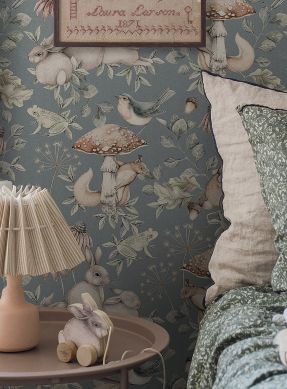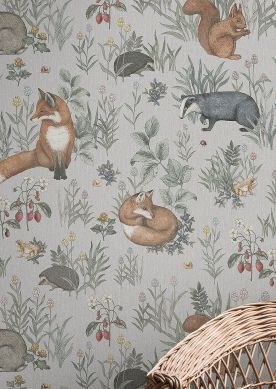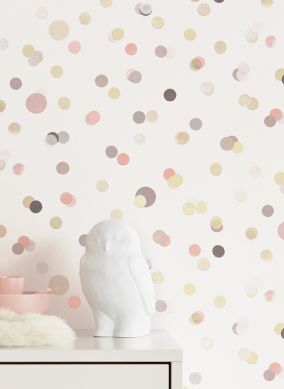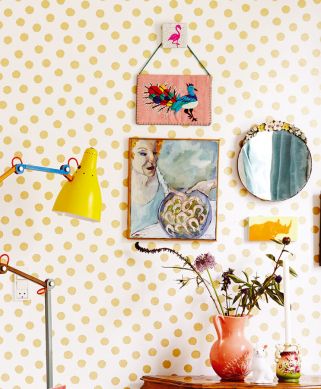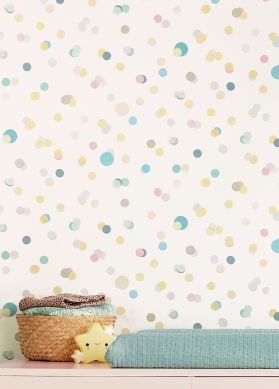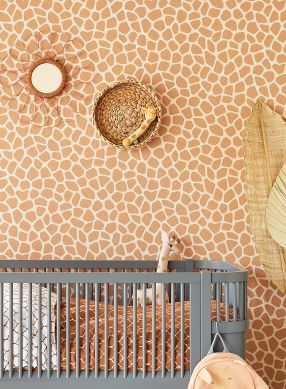Children’s Wallpaper
Children's wallpaper - The Guide
Children go through different developmental phases, and their rooms should be adapted to those with adequate furnishings and design. Colours and patterns play an important role when it comes to age- and development-appropriate wallpaper. Kids' wallpaper needs to work as both a design tool as well as a functional element. The right wallpaper models awaken joy and the playful instinct and can have a calming or motivating effect. They are a link between the external and the internal world of the child and promote creativity and support learning processes. Comfort and warmth are important factors for the room that children consider their safe haven. This guide explains what should be considered when using design wallpaper to create unique children's rooms.
Table of Contents
- How should kids’ rooms be furnished?
- Which colours can babies see?
- Which colours are best for children?
- What impact do colours and patterns have on child development?
- Which are the best wallpaper patterns for boys?
- Which are the best wallpaper patterns for girls?
- Are the various components of wallpaper harmless?
- How can wallpaper be used to separate different areas of children's rooms?
- Our tips: Ideas which will make children's eyes light up
How should kids’ rooms be furnished?
Kid's rooms change according to the developmental cycles of the child; they should be adapted to their abilities and interests. Whilst a baby's room requires very little space, a few years later the motto is: The older the children, the more space they need.
Baby room
Many young parents prepare the nursery before the baby arrives. They want everything to be in place by the time the child is born. In reality, the baby tends to sleep in a cot in the parent's room during the first weeks and months, a process which is also recommended by experts as it fosters social ties and encourages bonding. As a result, the baby usually doesn't really need his or her own room until it is supposed to start sleeping alone, e.g. from the 3rd month.
In terms of furniture, a baby bed, a changing unit and a small wardrobe or chest of drawers is all that is needed. Light wood nuances or white are ideal colours for baby room furniture and provide a neutral canvas for wallpaper. Clear, contrasting colours are great for babies' eyes. Simple geometric shapes in black and white are a great choice for babies, and due to their limited eyesight and acuity, large scale-patterns are good options. Soft nuances of red have a calming effect on tiny tots.
Toddlers
The infant stage lasts from age one to age three. Children become more agile and curious. They crawl on all fours and then learn to walk. Rooms for little explorers often feature a more flexible cot and lots of storage for toys. Child-appropriate seating is another popular option.
However, the room should not be over-furnished as what the child needs most is room to move. Motif wallpaper can support and foster a child's joy of discovery. Funny zoo, forest, and sea animals, cars, and delicate geometric patterns are all good options. At this age, children can see all basic colours as well as pastels, a fact that should be reflected when choosing wallpaper.
Kindergarten age
From the age of three, many children start going to kindergarten and enter an important new phase of life. They socialise with other children and adults, learn new rules, acquire basic social skills and experience boundaries. The first friendships are developed. The child's room becomes a place of retreat where experiences are processed, often in a playful manner, for instance with role-playing games.
The cot is swapped for a small bed, the changing unit disappears, making room for a small table or desk and a chair or a seating area with comfortable beanbags or armchairs. Personal interests and preferences start coming to the fore. Girls often develop a preference for dolls, horses, mythical creatures, whilst boys tend to discover a liking for cowboys, fire-fighters or airplanes. This is reflected in their choice of wallpaper motifs. Wallpaper models are more colourful and detailed and become a backdrop for imaginative games.
School age
From the age of five or six, children start school. Another significant phase begins and the room/wallpaper design options reflect this. School kids experience more challenging demands, they have to re-arrange their priorities, produce academic results, and expand their social competence. The child's room becomes a multi-functional space. Besides a child-appropriate bed, the desk is the centrepiece. A larger wardrobe, a chest of drawers, and a seating or reading area complete the picture.
It makes sense to systematically separate the areas for sleeping/studying/relaxing & playing, for instance by using various different wallpaper models. Wall/wallpaper colours and pattern motifs are increasingly adapted to the child's preferences and take psychological aspects into account. Whilst the area for studying benefits from stimulating colours and inspiring patterns, the space for relaxing and sleeping should feature more calming hues and imaginative wallpaper patterns.
Which colours can babies see?
When babies are born, their ability to see is limited as their eyesight develops slowly over the first year of life in order to protect them from sensory overload. This fact should be considered when choosing colour and motif of the wallpaper.
Visual capacity
Around the 7th month of pregnancy, unborn children first open their eyes and are able to distinguish between light and darkness. Light impulses are seen as shades of red through the mother's abdominal wall. After birth, the world is a very blurry place for new-born babies. Orientation is determined by light sources and movements. Their visual abilities gradually improve but are limited to the space directly in front of the face for the first few weeks. The child reacts mainly to bright colours and light/dark contrasts.
Scientists have found that very young babies enjoy the combination of black and white. Warm, soft hues of red are also a good choice as they remind them of the light impulses seen from inside the mother's belly. From the ninth week, the child can see with both eyes, and spatial awareness as well as the ability to see things at a distance are developed. From the 3rd month of life, babies can recognise and differentiate between the basic colours red, blue, and yellow. From month 5, they can see pastel hues, too.
Studies have found that at this age, babies prefer the colours red, orange, purple, and blue. Colours are a great way to develop visual abilities and this is not limited to wallpaper but should be taken into consideration for the entire room. To achieve this, colours can be neutral or muted. Accessories, furniture and toys in bright colours provide interesting contrasts for the child.
Visual acuity
A newborn's visual acuity is limited to the area closest to the eyes (about 20 - 25 cm). The child can recognise faces, especially those of direct caregivers. Strong, contrast-rich colours stimulate the optic nerve. Large graphical patterns, simple geometric shapes, or cute animal faces attract the attention of the child. From the 3rd month onwards, the baby focusses on bright primary colours, more complex shapes, and details.
One of the next important developmental steps is eye-to-hand coordination which helps to train depth perception. After about 10 to 12 months, the visual acuity reaches up to 50% of that of an adult. The child can now perceive all colours, if not the most subtle nuances and differences. In terms of wall design, bright, contrasting colours or pastels are both appropriate for this stage of children's development and their visual abilities.
Which colours are best for children?
Generally speaking, children love all bright colours. Nevertheless, it makes sense to focus on just a few favourite colours to avoid overstimulation. Gender can also play a role in terms of colour choices, but there are many hues that both girls and boys will like.
Gender-neutral (unisex)
Yellow, green, blue, and turquoise are just some of the gender-neutral colours enjoyed by both boys and girls. Yellow is right at the top of the list of favourites, and the tonality can stretch from a fruity lemon yellow via a soft vanilla shade to a warm gold or maize. One of the reasons is that this colour has many positive characteristics. Yellow creates a happy and lively atmosphere, it exudes energy and promotes self-confidence and optimism.
Green is another gender-neutral colour. In children's rooms where the emphasis is on activity, creativity and relaxation, green works perfectly as it supports all of these requirements. With its calming and relaxing characteristics, blue is another popular unisex colour. Experts recommend the combination of various shades of blue so that the room doesn't appear too cold. Turquoise also belongs to the most popular unisex colours for kids' rooms. This warm combination of green and blue provides energy, strengthens self-confidence and balances the mind.
Popular colours for boys
A combination of grey and white exudes modern coolness - and with the right pattern, it works for boys of all ages. This neutral hue provides clarity and structure - the perfect backdrop for colourful interior design ideas. According to surveys, red is another favourite colour for boys, be it for clothes or room design. This might seem surprising at first, but it ties in with their drive and adventurousness. However, red should be used sparingly in children's rooms, for instance limited to a feature wall, because in excess it can cause aggression.
Popular colours for girls
There's no question about it: the princess concept is alive and well. As a result, pink is still a favourite colour for girls of all ages. This romantic hue helps prevent bad moods and aggression. In addition, purple and violet have become firm favourites in kids' rooms. Both colours promote creativity, provide a harmonising balance and help with decision-making. Soft nuances of brown are perfect for active girls who love nature.
Our recommendation: Timeless colours are a better choice than fashionable or trendy combinations which children are likely to lose interest in as they grow older. Classic hues like blue, green, yellow, or grey are great examples.
What impact do colours and patterns have on child development?
The findings of colour psychology help when choosing specific colours according to their positive impact on children's creativity and their ability to learn. When deciding on the right pattern, the focus should be on the developmental stage of the child and his or her personal interests.
Creativity
Imagination and creativity are inextricably linked. Patterns which stimulate the imagination also promote creativity. Amongst the colours that increase creativity are orange, green, blue, purple, and violet. When used sparingly, red has a stimulating effect, too. Wallpaper patterns with interconnected motif elements (e.g. astronauts, rockets, planets) or story-telling qualities (e.g. a landscape with animals or fairy-tale characters) invite the child to contemplate possible connections, make up their own stories, or use the wallpaper as a backdrop to imaginative games. Long term, this strengthens their sense of creativity.
Children's creativity is transformed into activity. In this context, wallpaper that can be (co-) designed by children, for instance by painting or drawing on, is a great choice. Good examples are black-and-white patterns, picture frame motifs, and chalkboard or whiteboard models.
Ability to learn
Learning is a life-long process but children gain the most formative experiences and go through the steepest learning curves. Young children first learn about their immediate environment and then pick up walking and speaking. Intuitively, they train all their senses. Some time later, they expand their horizons by forging their first social contacts. At school, the decisive factor is attentiveness. Geometric patterns help children of all ages retain and increase their ability to learn. Even babies are fascinated by simple shapes, and as the child grows older, they can become more complex and multi-dimensional.
In children of school age, numbers and letters actively increase the willingness to learn. The simplicity of the pattern ensures that children aren't distracted from their actual objectives. Yellow promotes a child's intelligence as well as the ability to think, and increases concentration. Orange is performance-enhancing and supports learning skills. White helps with clear thinking and should feature as the base or pattern colour in wallpaper. For babies and toddlers, contrast-rich, strong shades or black and white stimulate little brains.
Which are the best wallpaper patterns for boys?
Bravery, adventures and action are amongst the favourite themes for boys' wallpaper. Even though there is a huge choice of pattern wallpaper for boys, the most favoured motifs continue to be cars, fire engines, forest animals, and superheroes.
Cars
Fast racing cars, big lorries, impressive tractors - the world of automobiles is as varied as the choice of wallpaper models. Even the smallest boys tend to find cars "cool"; they are magically drawn to speed and movement. In kids' TV series, cars even turn into talking friends and companions for many adventures. Cars stand for freedom and power, which is why in boys' rooms, they often aren't just present in the toy box but on the walls, too.
Fire Brigade
Most boys go through a phase where they want to become firemen when they grow up. In addition to the fascinating fire engines, boys are inspired by the courageous efforts of the firemen to save people and animals. So it is hardly surprising that wallpaper patterns or motifs focussed on the fire brigade continue to be favourites. Furthermore, they promote creativity because they can be used as the basis for fantastic tales of heroism.
Superheroes
Big, strong, powerful - superheroes know everything, can do anything they put their mind to, they are always there to save the day and find a solution for any problem. Superheroes are role models that boys aspire to be like and that help shape their characters. On boys' wallpaper, they are ever-present and might even become secret allies and imaginary friends.
Forest animals
In the dark, mysterious woods, many fascinating or cute animals hide. As for many kids it is rare to see them in nature, they often enjoy them on their walls. Does, rabbits, hedgehogs, bears - the list is endless. For many a boy, a cheerful crowd of forest animals is his idea of heaven.
Which are the best wallpaper patterns for girls?
Fairy-tale worlds, nature, animals, and mythical creatures are amongst the topics girls tend to be most interested in. The pattern motif wish-list also features princesses, farms, jungles, horses, and clouds.
Farm
Farm creatures big and small need to be tended to and spread fun wherever they are. Fields and meadows, perhaps a pond or lake - all these motifs feature on farm-themed wallpaper focussing on human and animal inhabitants. They appeal to many girls' interests and character traits. The appropriate wallpaper can help explore these topics in a playful-creative manner.
Jungle
Girls like exploring just as much as boys. However, their main focus is often on lush green and exotic plants and animals. The dense jungle combines untouched nature with exiting adventures and bright tropical colours. It creates the ideal environment for relaxing moments and provides fabulous ideas for playing.
Horses & Unicorns
Girls tend to love horses, especially during the transition period between kindergarten and school. This attraction can continue throughout the teenage years and turn into a sporty passion in adulthood. Girls like taking care of the four-legged friends, they might even have a favourite equine breed, and they enjoy imagining exiting riding adventures aided by toys, books and wallpaper motifs. Unicorns are the fairy-tale continuation of their love for horses.
Clouds
Soft, fluffy clouds invite girls to dream of flying above the world. Cloud patterns in just one or many different colours, with sunshine peeking through or droplets of rain falling down, are always a firm favourite for girls' wallpaper. Thoughts and wishes, but sorrows and worries, too, are all placed into the clouds and sent to the right address. Clouds also provide creative access to other heavenly spheres of the imagination.
Are the various components of wallpaper harmless?
All components of children's rooms - from wallpaper to flooring to furniture and toys - should be as pollutant-free as possible. A child's immune system needs time to develop fully, which means that the little ones are much more susceptible to poisonous substances in their environment.
Pollutant-free
It is no secret that some wallpaper types can contain pollutants. To name but a few, plasticisers (e.g. Phthalate), binding agents, volatile organic, organohalogen or organostannic compounds and Biocides might all be present. Children's wallpaper should contain none of these substances. Wallpaper types made from pure plant or wood fibres, cellulose and textile fibres, untreated or recycled paper or other recycled synthetic materials are all low-pollutant options. Breathability is an essential prerequisite for healthy room air.
Plant dyes, solvent-free printing dyes, and natural binding agents like rubber or resin can replace substances that are damaging to the health of a child. Unlike with foodstuffs, for wallpaper there is no duty to declare the substances contained. Therefore, it is important to check the manufacturers' seals of quality and certifications. The most common and well-known quality certifications for low-/zero-pollutant and environmentally sound wallpaper are, amongst others: The Blue Angel eco label, RAL, natureplus, Phthalate-free, and Eco Institute.
Environmentally friendly
The future belongs to our children - and today, they are so acutely aware of the current dangers to the environment that they have taken to the streets to fight for a healthy environment and climate protection. Environmentally sound wallpaper is produced from sustainable or recycled raw materials. Pesticides, herbicides and biocides are completely removed from the production chain, as are any chemicals that might be harmful to the water or the habitat of insects and wild animals. Environmentally friendly wallpaper is almost exclusively low-pollutant and features one of the above-mentioned quality seals or certifications.
How can wallpaper be used to separate different areas of children's rooms?
Children's priorities change as they grow older. Wallpaper can be used to achieve a multifunctional partition of the child's room into various different areas. For small children and toddlers, playing and relaxing/sleeping are the main focus. A child of school age requires spaces for learning/studying, sleeping and retreating.
Playroom
In kids' rooms which are mainly meant for playing, a stimulating wallpaper can be used for all walls or just one feature wall. The base colours should be light or white so that the pattern provides a distinct contrast. Patterns can be large-scale and "loud" - if they are too small, they can feel quite overwhelming.
Child's study
When it comes to studying and learning, concentration is the most important aspect. In terms of colours and patterns, wallpaper models used in this area should neither be too stimulating nor too tiring. The best place for a feature wall is the wall behind the desk, as this is often also the area which is first visible when opening the door to the child's room. Letters and numbers, geometric shapes or stripes are ideal choices. The remaining walls can be painted with a matching colour which reflects one of the pattern colours of the wallpaper.
Bedroom
Before going to sleep, or whilst relaxing, the child's eye should be focussing on calming, imaginative patterns and motifs. Good examples are whimsical dream scenes or large-scale landscapes. The best place for the wallpaper is the wall where the bed is. In babies' rooms, it is the area the child looks at directly from its cot. This could be the wall by the baby's head or the one opposite the cot, or even the ceiling.
Our tips: Ideas which will make children's eyes light up
- Involve the child(ren) when designing a themed room. For girls, this might be a bedroom fit for a princess in soft pink and gold hues, perhaps featuring tiaras or crowns, or a castle scene and a bit of glitter. Boys would appreciate a cosy pirate dwelling with a touch of the Caribbean. As well as the wallpaper, furnishings and accessories should be chosen with authenticity in mind.
- In children's rooms, large pieces of furniture like wardrobes or chests-of-drawers can be creatively beautified with wallpaper. One suggestion would be almost indestructible chalkboard wallpaper models which can be scribbled and drawn on with colourful chalk.
- Paint the wall in your child's favourite colour and use patterned wallpaper to create unusual decorative elements. For polka-dot patterns, you might want to choose circles, for striped patterns perhaps a triangular shape. Stick the cut-out shapes to the wall in whatever arrangement you and your child prefer.
- Kids' rooms' ceilings provide huge potential for the use of fabulous pattern wallpaper, too. For babies and toddlers, the motif might be a starry sky or a magical galaxy, for nature-loving kids a bucolic flower meadow. With the help if our Guide on How to wallpaper the ceiling, even beginners can have a go.










